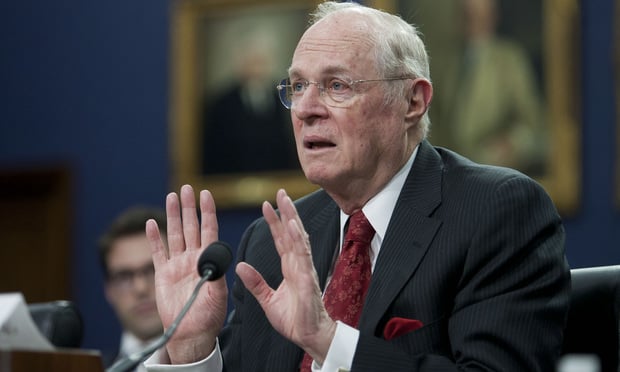The Justices Had 5 Votes to Overturn 'Roe' in 1992. Why That Didn't Happen.
The Casey case, which affirmed Roe's central holding, is getting renewed attention for the standard the decision set for determining whether a state law posed an "undue burden" on a woman's right to get an abortion.
May 16, 2019 at 03:02 PM
6 minute read
 Protesters stream by the U.S. Supreme Court in 2017 as part of a women's march in Washington. Photo: ALM Media
Protesters stream by the U.S. Supreme Court in 2017 as part of a women's march in Washington. Photo: ALM Media
In 1992, anti-abortion groups thought they had a winning case in defense of a restrictive Pennsylvania state law. There appeared to be five votes on the U.S. Supreme Court to overrule the landmark decision Roe v. Wade, but that did not happen. As Alabama and Missouri lawmakers adopt strict anti-abortion laws, and predict successful outcomes at the high court, history provides some lessons: Never bet on what occurs behind the high court's closed conference doors.
After oral arguments in Planned Parenthood of S.E. Pennsylvania v. Casey, Justices Harry Blackmun and John Paul Stevens believed the 1973 ruling in Roe was doomed.
Stevens, writing in his newly published book, “The Making of a Justice,” said the justices, except for him and Blackmun, agreed the U.S. Court of Appeals for the Third Circuit correctly upheld all of the challenged abortion restrictions—save for one, which required a married woman to certify she had notified her husband of her intent to have an abortion.
The Casey case, which affirmed Roe's central holding, is getting renewed attention today for the standard the decision set for determining whether a state law posed an “undue burden” on a woman's right to get an abortion. The justices are weighing several abortion-related challenges, and separately, new laws passed by Alabama and other Republican-led states could tee up direct challenges to Roe in the coming months.
Several new books, including the one from Stevens, offer a glimpse behind the scenes at how the Pennsylvania case was resolved and why caution is warranted in predicting the outcome in the most contentious cases.
“Harry and I both assumed that the result [in Casey] would be explained in an opinion overruling Roe v. Wade,” Stevens wrote in his autobiography, published this week.
In fact, at the justices' private conference, Chief Justice William Rehnquist counted five votes to reverse Roe, and he assigned the court's opinion to himself, according to journalist Evan Thomas in his new book, “First,” a biography of Sandra Day O'Connor.
 Justice Anthony Kennedy in March 2015 on Capitol Hill. Photo: Diego M. Radzinschi/National Law Journal
Justice Anthony Kennedy in March 2015 on Capitol Hill. Photo: Diego M. Radzinschi/National Law JournalRehnquist circulated a draft opinion for the court May 27, 1992, “that met our expectation—it did not expressly overrule Roe, but like his proposed opinion in the Webster case three years earlier, it effectively repudiated its central holding,” Stevens said in his book.
Two days later, then-Justice Anthony Kennedy sent a letter to Blackmun in which he asked to see the justice to convey some developments in the Casey case and some “welcome news.” Unknown to Blackmun and Stevens, Kennedy and justices O'Connor and David Souter had been meeting secretly to draft an opinion that would preserve Roe.
O'Connor “understood that it took some courage for the Catholic Kennedy to countenance any compromise or middle way on abortion rights,” according to the book that Thomas wrote about O'Connor. She and Souter had persuaded Kennedy to change his initial conference vote and to take a personal risk “by appealing to his basic sense of decency and fairness”—and, perhaps most importantly, his strong belief in individual liberty.
Kennedy would begin the three justices' joint opinion by writing: “Liberty finds no refuge in the jurisprudence of doubt.”
Their draft opinion circulated June 3, 1992, just one week after Rehnquist believed his draft would be the court's opinion.
Stevens said he asked the “troika” of justices for some minor changes so that he could join their opinion. His changes were accepted. “In my view, an opinion that begins as an opinion of the court and continues to speak for the court for 25 pages would be far more powerful than one that starts out as a plurality opinion and shifts back and forth between a court opinion and a plurality opinion.”
The Supreme Court of today, of course, is not the same as yesteryear. Kennedy retired last year, and he was replaced by Brett Kavanaugh, a longtime Washington federal appeals judge who observers expect could take a hard line against pro-abortion arguments.
Chief Justice John Roberts Jr. now becomes the central focus in abortion cases, mainly because of his concern that the court not be viewed as a partisan institution. But he has never voted to strike down a state abortion restriction.
 Justice Neil Gorsuch, left, and Chief Justice John Roberts Jr., walk down the steps of the U.S. Supreme Court after Gorsuch's investiture in January. Photo: Diego M. Radzinschi/ALM
Justice Neil Gorsuch, left, and Chief Justice John Roberts Jr., walk down the steps of the U.S. Supreme Court after Gorsuch's investiture in January. Photo: Diego M. Radzinschi/ALMIn the high court's most recent abortion decision—Whole Woman's Health v. Hellerstedt in 2016—Roberts joined the dissenters in a 5-3 decision that invalidated Texas's restrictions on abortion clinics and their physicians. The opening lines of Justice Stephen Breyer's majority ruling cited the 1992 Pennsylvania abortion ruling.
More recently, Roberts joined the court's liberal wing in February to block temporarily Louisiana clinic restrictions nearly identical to the Texas law. His vote, in the case June Medical Services v. Gee, was not on the merits of the challenge. The majority's action only stayed the effective date of the law until the challengers filed and the court acted on a petition for review.
The Pennsylvania abortion case isn't the only example of how conference votes may change dramatically and upset widespread expectations. The most recent example is Roberts's role in the court's review of President Barack Obama's signature policy initiative—the Affordable Care Act.
Roberts initially voted in the justices' secret conference to strike down the individual mandate to purchase health insurance and to uphold the expansion of Medicaid. Two months later, as Joan Biskupic reports in her new book, “The Chief,” Roberts shifted positions on both.
While predictable in some areas of the law, the Supreme Court is often most unpredictable in areas where its institutional credibility is at stake. In 2012, Justice Ruth Bader Ginsburg had the wisest advice for court watchers during those situations: “It ain't over till it's over.”
Read more:
Breyer Denounces Ruling That Strikes Precedent, Questions Which Cases Are Next
Vitter Becomes Trump's 65th District Judge, Surmounting Criticism on Abortion Views
Women Lawyers' Group Stands Up for Liu After DOJ Nomination Scuttled
New O'Connor Book Chronicles Her Dementia Onset, Frustration With Alito
Roberts Joins Liberal Wing to Block Louisiana Abortion Clinic Law
Divided 6th Circuit Rules Against Planned Parenthood in Ohio Funding Fight
This content has been archived. It is available through our partners, LexisNexis® and Bloomberg Law.
To view this content, please continue to their sites.
Not a Lexis Subscriber?
Subscribe Now
Not a Bloomberg Law Subscriber?
Subscribe Now
NOT FOR REPRINT
© 2025 ALM Global, LLC, All Rights Reserved. Request academic re-use from www.copyright.com. All other uses, submit a request to [email protected]. For more information visit Asset & Logo Licensing.
You Might Like
View All
'Religious Discrimination'?: 4th Circuit Revives Challenge to Employer Vaccine Mandate
2 minute read
4th Circuit Revives Racial Harassment Lawsuit Against North Carolina School District
3 minute read

DOJ, 10 State AGs File Amended Antitrust Complaint Against RealPage and Big Landlords
4 minute readTrending Stories
- 1Plaintiff Argues Jury's $22M Punitive Damages Finding Undermines J&J's Talc Trial Win
- 2Bannon's Fraud Trial Delayed One Week as New, 'More Aggressive,' Defense Attorneys Get Ready
- 3'AI-Generated' Case References? This African Law Firm Is Under Investigation
- 4John Deere Annual Meeting Offers Peek Into DEI Strife That Looms for Companies Nationwide
- 5Why Associates in This Growing Legal Market Are Leaving Their Firms
Who Got The Work
J. Brugh Lower of Gibbons has entered an appearance for industrial equipment supplier Devco Corporation in a pending trademark infringement lawsuit. The suit, accusing the defendant of selling knock-off Graco products, was filed Dec. 18 in New Jersey District Court by Rivkin Radler on behalf of Graco Inc. and Graco Minnesota. The case, assigned to U.S. District Judge Zahid N. Quraishi, is 3:24-cv-11294, Graco Inc. et al v. Devco Corporation.
Who Got The Work
Rebecca Maller-Stein and Kent A. Yalowitz of Arnold & Porter Kaye Scholer have entered their appearances for Hanaco Venture Capital and its executives, Lior Prosor and David Frankel, in a pending securities lawsuit. The action, filed on Dec. 24 in New York Southern District Court by Zell, Aron & Co. on behalf of Goldeneye Advisors, accuses the defendants of negligently and fraudulently managing the plaintiff's $1 million investment. The case, assigned to U.S. District Judge Vernon S. Broderick, is 1:24-cv-09918, Goldeneye Advisors, LLC v. Hanaco Venture Capital, Ltd. et al.
Who Got The Work
Attorneys from A&O Shearman has stepped in as defense counsel for Toronto-Dominion Bank and other defendants in a pending securities class action. The suit, filed Dec. 11 in New York Southern District Court by Bleichmar Fonti & Auld, accuses the defendants of concealing the bank's 'pervasive' deficiencies in regards to its compliance with the Bank Secrecy Act and the quality of its anti-money laundering controls. The case, assigned to U.S. District Judge Arun Subramanian, is 1:24-cv-09445, Gonzalez v. The Toronto-Dominion Bank et al.
Who Got The Work
Crown Castle International, a Pennsylvania company providing shared communications infrastructure, has turned to Luke D. Wolf of Gordon Rees Scully Mansukhani to fend off a pending breach-of-contract lawsuit. The court action, filed Nov. 25 in Michigan Eastern District Court by Hooper Hathaway PC on behalf of The Town Residences LLC, accuses Crown Castle of failing to transfer approximately $30,000 in utility payments from T-Mobile in breach of a roof-top lease and assignment agreement. The case, assigned to U.S. District Judge Susan K. Declercq, is 2:24-cv-13131, The Town Residences LLC v. T-Mobile US, Inc. et al.
Who Got The Work
Wilfred P. Coronato and Daniel M. Schwartz of McCarter & English have stepped in as defense counsel to Electrolux Home Products Inc. in a pending product liability lawsuit. The court action, filed Nov. 26 in New York Eastern District Court by Poulos Lopiccolo PC and Nagel Rice LLP on behalf of David Stern, alleges that the defendant's refrigerators’ drawers and shelving repeatedly break and fall apart within months after purchase. The case, assigned to U.S. District Judge Joan M. Azrack, is 2:24-cv-08204, Stern v. Electrolux Home Products, Inc.










